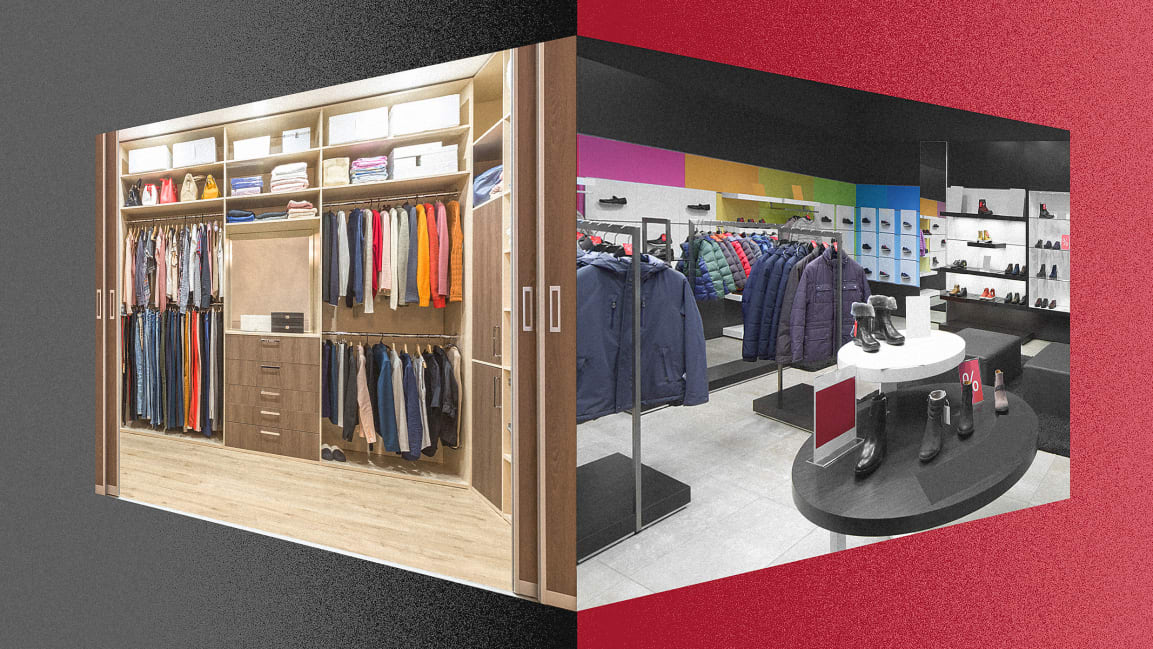 Fall is a prime time for overconsumption, with back-to-school and jacket season in full force. What if you tried to buy nothing at all?
Fall is a prime time for overconsumption, with back-to-school and jacket season in full force. What if you tried to buy nothing at all?
Like clockwork, when the crisp fall weather arrives, stores fill up with cozy new clothes and magazines are splashed with the latest looks from New York Fashion Week. All of this sends a subliminal message that we should stock up on jackets and sweaters in autumnal colors and buy our kids new back-to-school outfits.
But by now it’s clear that our consumption habits are driving the planet to the brink of collapse by accelerating global warming and polluting the environment. We tend to consume mindlessly: We’re conditioned by brands to buy new products out of habit or impulse, rather than because we need them. So this year, I’m proposing a radical experiment. What if we resist the urge to shop, and instead choose to buy nothing at all for a season?
At first blush, this might sound totally unappealing. After all, fall shopping is a delightful tradition rooted in nostalgia for our own back-to-school days. “Shopping definitely gives us a short-term dopamine hit,” says Laura Wittig, cofounder of Brightly, a startup that promotes conscious consumption, including abstaining from shopping when possible. “And when the stores are full of back-to-school marketing and new products, it can be very hard to resist.”
But the good news is that there are ways to acquire the things we really need—and even experience the joy of a seasonal wardrobe refresh—without going shopping. In fact, there’s a movement bubbling across the country to stop buying new clothes entirely. Those who are part of it say they’re just as stylish and happy as ever.
WHY WOULD YOU DO THIS?
Choosing not to shop is a major lifestyle change, one that seems revolutionary in a capitalist society. Before embarking on this journey, it makes sense to understand why it’s worth going against the grain. Ayesha Barenblat, founder and CEO of ethical fashion nonprofit Remake, has thought a lot about this inherent tension. Over the summer, her organization challenged people around the world to pledge to stop buying new clothes for three months, and thousands of people signed up.
Barenblat notes that the apparel industry alone is responsible for 5% to 8% of all global greenhouse gas emissions, 20% of wastewater worldwide, and 35% of all microplastics in our oceans. But what many people don’t realize is that keeping our closets stocked with cheap, fashionable clothes can come at the expense of millions of predominantly female workers around the world. In order for companies to churn out clothes at their current pace, they have to pay workers sweatshop wages.
“It’s a lie to think that buying these clothes will lift a generation of Black and brown women out of poverty,” Barenblat says. “If we move workers to a living wage and had a humane pace of production, we would be [addressing] both the environmental and humanitarian crisis at the same time.”

Choosing not to buy any new pieces for three months allows us to move closer to a more reasonable pace of consumption. Barenblat believes that consumers who join this movement can signal to the industry that they no longer support the fast-fashion business model and instead want companies to pay workers more and give them more humane working conditions, even if this means that prices go up. And if you’re concerned that abstaining from shopping may harm small businesses or workers in the short term, Barenblat suggests taking the money you’ll save and donating it to organizations supporting garment workers or buy gift cards to local boutiques.
DO AN AUDIT
So how do you get started? The first step is take inventory of what you already have, Wittig suggests. Most of us haven’t seen our jackets, sweaters, and scarves in months, so we may have forgotten how many we actually love wearing. This may prompt you to enjoy the things you already own and not add more clutter to your closet. “It’s a happy coincidence that the movement to buy less coincided with shows like Tidying Up With Marie Kondo and The Home Edit,” Wittig says. “They show us how minimalism can be really liberating.”
The next step is to start organizing. Put aside clothes that don’t fit or that you don’t actually wear, then neatly arrange the items that remain. When you’ve done this, you might discover that there are things you do actually need. Perhaps some key fall pieces no longer fit, or you need professional clothes for a new job, or your children have outgrown their jackets from last year. Or perhaps you’re just looking for something exciting to spice up your fall wardrobe.
GET YOUR FASHION FIX
For many people who have given up shopping, clothing swaps are a great way to find high-quality pieces. While a swap might seem daunting to the uninitiated, Barenblat says it can be as easy as finding a few friends whose tastes you admire and who wear a similar size, then having a conversation about what pieces you’d like to part with and what pieces you might need.
If you’re more ambitious, you can opt for a bigger clothing swap. Organizations like the Global Fashion Exchange allow you to find large-scale swaps in your city, but it’s also easy to organize your own event. People can pool their unwanted clothes, then sort them by size, before inviting others to stop by to take what they want; any remaining items can be donated. Wittig says she found a gorgeous, unworn Sézane sweater at a swap organized by the Wing. There are also plenty of virtual clothing and product swaps on Facebook; you can find one in your community on the Buy Nothing Project’s website. And Swap Society allows you to send in clothes you don’t want and pick out products that others have sent in.
But even when clothes are free, Wittig says it’s still important to be conscious about what you take home. It’s easy to take items you don’t need or won’t actually use. She suggests picking only items that fit well, have a classic design, and can be worn in several different contexts, like jeans that can be dressed up or down.
If the idea of a clothing swap seems too involved, there are other options. One that I like is gathering the unwanted clothes in your closet and selling them to a consignment store in exchange for store credit. I recently cleaned out my closet by sending 15 garments to the online consignment store ThredUp, which offers payment in cash, store credit, or gift cards to fashion brands. I used my earnings to buy two pieces for fall from a brand called Cuyana that I can’t wait to wear.
WHAT ABOUT BACK-TO-SCHOOL?
If you’re a parent, you likely feel the need to get your children ready for school by buying them new backpacks, clothes, and supplies. While it’s easy to give in to the magnetic pull of stores like Old Navy or Target, with their enticing back-to-school ad campaigns, Wittig suggests getting more creative.

If your child’s old backpack is still in good shape, you could give it a good clean and customize it for this year with fun patches or charms. And when it comes to clothes, see if you can find a local parent’s group—either in your neighborhood or on Facebook—to outfit your child with hand-me-downs. It’s often possible to find kids’ clothes that are barely worn or in excellent condition since kids can outgrow some of their clothes before they’ve had a chance to get much use out of them.
To make receiving these clothes more fun, Wittig suggests injecting some magic into it. Package the items nicely—perhaps reusing tissue paper and bags from a nice store, or even using some gift wrap—so your kids still have fun “unboxing” the pieces. “Brands are very good at creating an exciting experience around shopping, so why not steal some of their tricks,” she says. “You can get the kick out of getting something that is new to you, without the immense environmental damage.”
AFTER THE FALL
If you decide to stop shopping, good for you! You’re doing your part to reduce your environmental footprint. As you go into it, Barenblat and Wittig suggest being kind to yourself and staying flexible. You don’t want to feel so deprived that you give up on the challenge. Wittig suggests that you gamify things for yourself: Perhaps for every three used items you acquire, you can give yourself a little treat, like a pint of gourmet ice cream or a new plant. And if there’s something you absolutely need to buy—like new underwear or a pair of sneakers—just go for it. It doesn’t mean you’re cheating.
“The goal is to make us all more mindful about what we are buying and the impact it has,” Barenblat says. “It should be beautiful and meaningful, not something that causes stress.”
But as Barenblat has connected with the thousands of people who committed to not buying clothes for three months, she has found that many enjoyed it so much they’re planning to make it an ongoing part of their lives. Some talk about how they love their minimal, uncluttered closets full of pieces they actually wear; others say they feel like they’re bringing about positive change.
“I think a project like this makes it clear that stuff does not bring real happiness,” she says. “People discovered they got far more meaning from other things, like being part of a movement and connecting with a community.”
—
Guest Author: ELIZABETH SEGRAN
This article first appeared in www.fastcompany.com
Seeking to build and grow your brand using the force of consumer insight, strategic foresight, creative disruption and technology prowess? Talk to us at +971 50 6254340 or engage@groupisd.com or visit www.groupisd.com/story

